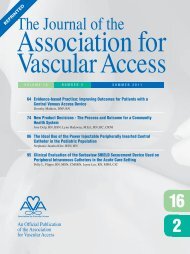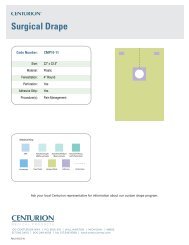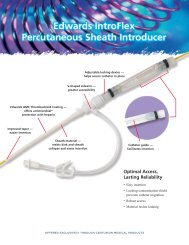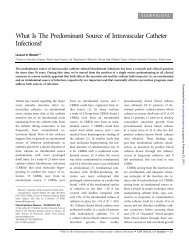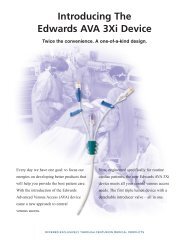Decreased Costs/Improved Outcomes With ... - CVCBundle.com
Decreased Costs/Improved Outcomes With ... - CVCBundle.com
Decreased Costs/Improved Outcomes With ... - CVCBundle.com
You also want an ePaper? Increase the reach of your titles
YUMPU automatically turns print PDFs into web optimized ePapers that Google loves.
REPRINTED<br />
The following article appeared in the Journal of the Association for Vascular Access (JAVA),<br />
the official publication of the Association for Vascular Access (AVA).<br />
For more information, contact AVA at 1-888-576-2826 or visit our website at www.avainfo.org.<br />
B A S I C S C I E N C E<br />
<strong>Decreased</strong> <strong>Costs</strong>/<strong>Improved</strong> <strong>Out<strong>com</strong>es</strong><br />
<strong>With</strong> Standardized Intravenous Equipment<br />
Elayne Penney-Timmons, RN, BGS, CRNI<br />
ABSTRACT<br />
Presented is a study of phlebitis and<br />
infiltration rates within an institution<br />
following the conversion to a standard<br />
intravenous (IV) start kit that included<br />
chlorhexidine gluconate with isopropyl<br />
alcohol, a new site dressing, and IV<br />
securement cushions. Included are cost<br />
<strong>com</strong>parisons and support rationale used<br />
in the purchase of the kit. The total number<br />
of intravenous sites examined was<br />
1,345. Using current nursing staff,<br />
peripheral IV phlebitis and infiltration<br />
rates were virtually eliminated and dwell<br />
times were extended from 72 to 96 hr.<br />
The challenge of providing excellent<br />
infusion nursing care in a state where<br />
Correspondence concerning this article<br />
should be addressed to<br />
EPenney-Timmons@mercydesmoines.org<br />
Medicare reimbursement for care is<br />
minimal can seem overwhelming. Clinicians<br />
at a 700-bed facility in the Midwest<br />
require a great deal of justification<br />
to approve any product changes or<br />
additional employees.<br />
The facility’s “intravenous (IV) team”<br />
was disbanded in 1993. The team had<br />
been small, and duties were limited to<br />
difficult peripheral IV starts, peripherally<br />
inserted central catheter (PICC)<br />
insertions, and nursing education. In<br />
1997 an infusion clinician was hired<br />
primarily to provide education in vascular<br />
access care. It was apparent that<br />
nurses had developed their own techniques<br />
for peripheral IV starts after the<br />
loss of the IV team. Skin preparation,<br />
site dressings, taping, and tourniquet<br />
use varied significantly.<br />
The U.S. Centers for Disease Control<br />
and Prevention (CDC) made the following<br />
statement in their 2002 Guidelines<br />
for the Prevention of Intravascular<br />
Catheter-Related Infections (1):<br />
“Reports spanning the past two<br />
decades have consistently demonstrated<br />
that risk for infection declines<br />
following standardization of aseptic<br />
care, and that insertion and maintenance<br />
of intravascular catheters by<br />
inexperienced staff might increase<br />
the risk for catheter colonization and<br />
CRBSI [catheter related bloodstream<br />
infection]. Specialized ‘IV teams’<br />
have shown unequivocal effectiveness<br />
in reducing the incidence of<br />
catheter-related infections and associated<br />
<strong>com</strong>plications and costs. Additionally,<br />
infection risk increases with<br />
nursing staff reductions below a critical<br />
level” (p. 5).<br />
Reinstituting an IV team was the<br />
most appropriate response to this situ-<br />
20 | JAVA | Vol 10 No 1 | 2005
ation, especially given the new CDC<br />
guidelines. However, achieving<br />
approval for this seemed highly<br />
unlikely. Instead, the infusion clinician<br />
decided to standardize IV care by<br />
implementing new protocols to be performed<br />
by the general nursing staff.<br />
Rationale for this decision<br />
included:<br />
1. General duty nurses were accepting<br />
full responsibility for patients’ IV<br />
access from initiating and monitoring<br />
the IV and solutions through discontinuing<br />
use of the device.<br />
2. A considerable number of nurses<br />
had developed skills in performing<br />
these tasks.<br />
3. The Intravenous Nursing Society’s<br />
(INS) Standards of Practice (2) stated<br />
that “an organization that fails to maintain<br />
an ongoing phlebitis rate of 5% or<br />
less with the practice of 72-hour<br />
catheter site rotation should return to a<br />
48-hour site rotation interval” (p. S50).<br />
This hospital demonstrated phlebitis<br />
rates in February and December 2002<br />
of 3% and 4%, respectively. Although<br />
lower rates are always preferable, the<br />
rate was within an acceptable range.<br />
The routine procedure for the institution’s<br />
peripheral IV starts in 2002<br />
included use of an IV tray, which<br />
included the following items: a tourniquet,<br />
sterile 2 x 2-in. gauze pads, IV<br />
catheters in a variety of sizes, tape, sterile<br />
70% alcohol pads, extension tubing<br />
with a needleless valve, and sterile<br />
povidone-iodine pads. The nurse performing<br />
the procedure would take the<br />
tray to the patient’s bedside for the IV<br />
start and then return the tray to the<br />
nursing station. Nurses followed their<br />
own preferred techniques using the<br />
items on the tray. Dressings applied on<br />
the IV sites included <strong>com</strong>binations of<br />
tape and a transparent dressing. One IV<br />
tray was maintained for each hospital<br />
wing, or approximately 20 patients.<br />
This practice raised obvious concerns<br />
regarding the spread of infectious disease.<br />
According to the CDC (1), “Migration<br />
of skin organisms at the insertion<br />
site into the cutaneous catheter tract<br />
with colonization of the catheter tip is<br />
the most <strong>com</strong>mon route of infection for<br />
peripherally inserted, short-term<br />
Figure 1. Sterile, single-use IV start kit.The kit included a preparation of 2% chlorhexidine<br />
gluconate (CHG) with 70% isopropyl alcohol. Kit manufactured by Tri-State Hospital<br />
Supply (Howell, MI).<br />
catheters” (p. 5). The INS’s Standards of<br />
Practice (2) re<strong>com</strong>mended, “The tourniquet<br />
should be single-patient use due<br />
to the potential for microbial cross-contamination<br />
between patients” (p. S36).<br />
The tourniquet on the IV tray was<br />
reused on a number of patients.<br />
The trial of a sterile, single-use IV start<br />
kit was proposed to create a standard<br />
procedure and provide a consistent use<br />
of materials for all IV starts. The facility<br />
set several goals and objectives: first, to<br />
standardize IV start materials and procedures;<br />
second, to reduce phlebitis rates;<br />
and, third, to do all of this with existing<br />
nursing staff.<br />
METHODS<br />
Nursing departments tested a variety<br />
of kits offered within this hospital’s<br />
buying group and felt that the Centurion<br />
IV Securement Kit (Tri-State Hospital<br />
Supply, Howell, MI) was the best<br />
choice (Figure 1). This kit featured a<br />
window dressing that the nurses determined<br />
to be the most <strong>com</strong>fortable and<br />
adherent. The kit included a prep of<br />
2% chlorhexidine gluconate (CHG)<br />
with 70% isopropyl alcohol. Studies<br />
have shown that CHG with isopropyl<br />
alcohol provides immediate and persistent<br />
antimicrobial activity and is effective<br />
in reducing the risk of infections<br />
21 | JAVA | Vol 10 No 1 | 2005
associated with IV lines (3–6). The kit<br />
also contained catheter securement<br />
cushions, a tape strip, 2 x 2 gauze, a<br />
latex-free tourniquet, and an extension<br />
set with needleless valve.<br />
The nursing staff reported an immediate<br />
benefit of this new IV securement kit<br />
in improved site visibility, as only one<br />
small strip of tape was used proximal to<br />
the dressing for added securement. The<br />
CDC guideline (1) from 2002 also stated,<br />
“Transparent dressings reliably secure<br />
the device, permit continuous visual<br />
inspection of the catheter site…and<br />
require less frequent changes than do<br />
standard gauze and tape dressings; the<br />
use of these dressings saves personnel<br />
time” (p. 7). Though the previous dressing<br />
had been transparent, visibility had<br />
been obscured at times by various taping<br />
methods.<br />
To achieve support and <strong>com</strong>pliance<br />
in the purchase and use of the kit, brief<br />
presentations were given to educate<br />
directors as to the intent of the kit. The<br />
product buyers agreed with the concept<br />
of an IV start kit but felt the additional<br />
costs would be excessive. However,<br />
once the cost of each item used in the<br />
current procedure was <strong>com</strong>pared with<br />
the cost of the new kit, the buyers were<br />
able to illustrate a significant cost savings<br />
of 34% annually, or $188,640 (see<br />
Table 1). <strong>With</strong> the potential advantages<br />
of improved care and actual cost savings,<br />
the purchasing, supply, nursing<br />
and radiology directors were very supportive<br />
in implementing the kit.<br />
RESULTS<br />
The kits arrived in January 2003. The<br />
manufacturer provided hands-on training<br />
in the appropriate use of the kit at<br />
various sites and times. Consistent kit<br />
usage throughout the hospital was<br />
achieved by March 2003.<br />
The out<strong>com</strong>e was monitored by<br />
assessing the phlebitis and infiltration<br />
rates at approximately 6-month intervals.<br />
These assessments were performed<br />
randomly on approximately<br />
250 patients per assessment (nurses<br />
were not informed about up<strong>com</strong>ing<br />
assessments; they were unexpected).<br />
Phlebitis was almost eliminated and the<br />
infiltration rate was zero (see Chart 1<br />
and Table 2).<br />
After the new kit was in use consistently<br />
throughout the hospital, dwell<br />
times were extended from 72 hr to 96<br />
hr in March 2003. The CDC guidelines<br />
(1) stated, “In adults, replace short,<br />
peripheral venous catheters at least<br />
72–96 hours to reduce the risk for<br />
phlebitis” (p. 9). Because the phlebitis<br />
rate had been acceptable prior to initiating<br />
the IV securement kit, administrators<br />
decided to make this change after<br />
the success of the kit.<br />
DISCUSSION<br />
One reason for the improved out<strong>com</strong>es<br />
is likely the fact that the catheter<br />
was stabilized more securely by consistently<br />
using the catheter securement<br />
strips provided in the kit (Figure 2).<br />
“If you don’t secure a catheter to<br />
prevent it from ‘pistoning’ in and out<br />
of the insertion site, your patient is<br />
at risk for developing thrombotic<br />
<strong>com</strong>plications, mechanical phlebitis,<br />
and catheter tip malposition. Skin<br />
organisms can also contaminate the<br />
catheter’s external portion, introducing<br />
pathogens directly into the<br />
bloodstream if the catheter migrates<br />
into the insertion site” (7; p. 13).<br />
There is also a reduced risk of infection<br />
by introducing CHG into the siteprepping<br />
protocol, along with providing<br />
a process improvement in technique by<br />
using the sterile kit during the placement<br />
of the peripheral venous device.<br />
In addition to real cost savings, the<br />
reduction in phlebitis rates added a soft<br />
cost savings to the hospital by reducing<br />
unscheduled restarts and other expenditures<br />
associated with such <strong>com</strong>plications.<br />
Nursing time per procedure<br />
decreased from an average reported<br />
time of 25 min without the kit to 15 min<br />
with the new kit. Extending the dwell<br />
time from 72 hr to 96 hr also decreased<br />
costs in both nursing time and materials.<br />
Patients benefited from increased<br />
<strong>com</strong>fort, fewer restarts, and a more<br />
<strong>com</strong>fortable site; nursing reported a<br />
lower incidence of skin tearing with<br />
the window dressing than with the<br />
22 | JAVA | Vol 10 No 1 | 2005
prior transparent dressing that had<br />
been used.<br />
CONCLUSION<br />
The implementation of a standardized<br />
protocol for all IV starts allowed<br />
the hospital staff to meet and exceed<br />
their objectives: using current nursing<br />
staff, they virtually eliminated peripheral<br />
IV phlebitis and maintained an<br />
infiltration rate of zero while extending<br />
dwell times. The use of a sterile, single-use<br />
IV securement kit containing a<br />
window dressing, catheter securement<br />
cushions, CHG, and isopropyl alcohol<br />
improved out<strong>com</strong>es and reduced both<br />
real and soft annual costs to the hospital.<br />
The reimplementation of a specialized<br />
IV team was proven unnecessary;<br />
instead, the hospital was able to realize<br />
cost savings while improving infusion<br />
nursing care.<br />
RESULTS<br />
Phlebitis Rates<br />
• Virtually eliminated at time of multiple<br />
assessments<br />
Infiltration Rates<br />
• Zero at time of multiple assessments<br />
Hard Cost Savings<br />
• Annual real cost savings of 34% or<br />
$188,640<br />
Soft Cost Savings<br />
• Nursing time decreased from an<br />
average of 25 min to 15 min per<br />
Figure 2. Stabilized peripheral IV site.<br />
procedure<br />
• Reducing phlebitis rates resulted in<br />
lower expenditures and fewer<br />
unscheduled restarts<br />
• Extending catheter dwell time protocols<br />
saved nursing time and materials<br />
• Standardization of protocol and<br />
improved site prepping reduced<br />
risk of costly infections<br />
• No need to hire additional nursing<br />
staff<br />
Patient Benefits<br />
• Increased <strong>com</strong>fort: fewer site <strong>com</strong>plications,<br />
skin tears and unscheduled<br />
restarts<br />
• Increased safety: lower risk of<br />
infection ♥<br />
Elayne Penney-Timmons, RN, CRNI,<br />
BGS, has been the Infusion Clinician at<br />
Mercy Medical Center since 1997. Her<br />
clinical background includes infusion<br />
therapy, critical care nursing, med-surgical<br />
nursing, home care, and home<br />
infusion. She received her PICC inserter<br />
certification in 1986 and her certification<br />
in intravenous nursing in 1995.<br />
REFERENCES<br />
1. Centers for Disease Control and Prevention.<br />
(2002). Guidelines for the Prevention<br />
of Intravascular Catheter-related<br />
Infections. Morbidity and Mortality<br />
Weekly Report; 51(RR10), 1–36.<br />
2. Intravenous Nurses Society. (2000).<br />
Infusion nursing standards of practice.<br />
Journal of the Intravenous Nurses Society;<br />
23(6S), S1–S88.<br />
3. Chaiyakunaprak, N, et al. (2003). Vascular<br />
catheter site care: The clinical and<br />
economic benefits of chlorhexidine gluconate<br />
<strong>com</strong>pared with povidone iodine.<br />
Clinical Infectious Diseases; 37, 764–771.<br />
4. Garland, J S, Buck, R K, Maloney, P,<br />
Durkin, D M, Toth-Lloyd, S, et al.<br />
(1995). Comparison of 10% povidoneiodine<br />
and 0.5% chlorhexidine gluconate<br />
for the prevention of peripheral<br />
intravenous catheter colonization in<br />
neonates: A prospective trial. Pediatric<br />
Infectious Disease Journal; 14, 510–516.<br />
5. Hibbard, J S, Mulberry, G K, & Brady,<br />
A R (2002). A clinical study <strong>com</strong>paring<br />
the skin antisepsis and safety of ChloraPrep,<br />
70% isopropyl alcohol, and 2%<br />
aqueous chlorhexidine. Journal of the<br />
Intravenous Nurses Society; 25, 244–249.<br />
6. Meffre, C, Girard, R, et al. (1996). Povidone-iodine<br />
vs alcoholic chlorhexidine<br />
for disinfection of the insertion site of<br />
peripheral venous catheters: Results of<br />
a multicenter randomized trial. Infection<br />
Control and Hospital Epidemiology; 17<br />
(Suppl. 2), A64.<br />
7. Rosenthal, K (2003). Bug patrol: Preventing<br />
I.V. infections. Nursing Made<br />
Incredibly Easy!, 1, 10–15.<br />
23 | JAVA | Vol 10 No 1 | 2005




